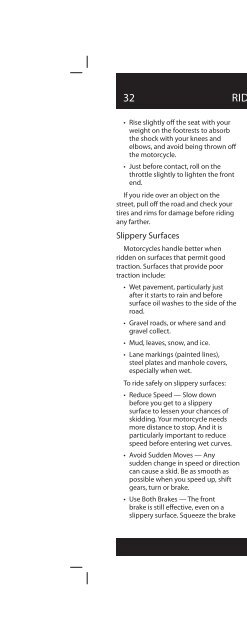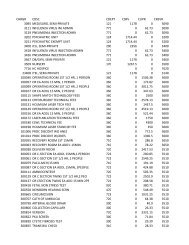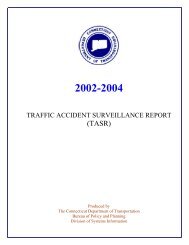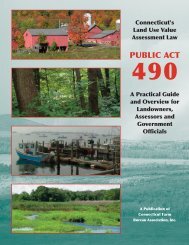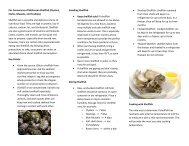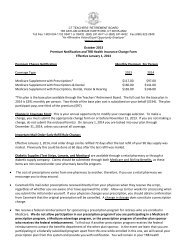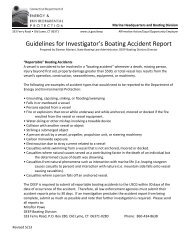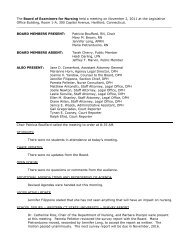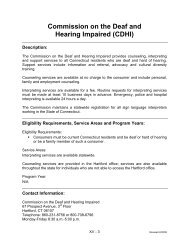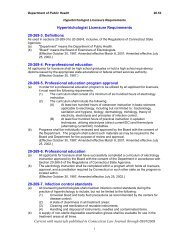The Connecticut Motorcycle Operator's Manual - CT.gov
The Connecticut Motorcycle Operator's Manual - CT.gov
The Connecticut Motorcycle Operator's Manual - CT.gov
Create successful ePaper yourself
Turn your PDF publications into a flip-book with our unique Google optimized e-Paper software.
32 RIDE WITHIN YOUR ABILITIES<br />
• Rise slightly off the seat with your<br />
weight on the footrests to absorb<br />
the shock with your knees and<br />
elbows, and avoid being thrown off<br />
the motorcycle.<br />
• Just before contact, roll on the<br />
throttle slightly to lighten the front<br />
end.<br />
If you ride over an object on the<br />
street, pull off the road and check your<br />
tires and rims for damage before riding<br />
any farther.<br />
Slippery Surfaces<br />
<strong>Motorcycle</strong>s handle better when<br />
ridden on surfaces that permit good<br />
traction. Surfaces that provide poor<br />
traction include:<br />
• Wet pavement, particularly just<br />
after it starts to rain and before<br />
surface oil washes to the side of the<br />
road.<br />
• Gravel roads, or where sand and<br />
gravel collect.<br />
• Mud, leaves, snow, and ice.<br />
• Lane markings (painted lines),<br />
steel plates and manhole covers,<br />
especially when wet.<br />
To ride safely on slippery surfaces:<br />
• Reduce Speed — Slow down<br />
before you get to a slippery<br />
surface to lessen your chances of<br />
skidding. Your motorcycle needs<br />
more distance to stop. And it is<br />
particularly important to reduce<br />
speed before entering wet curves.<br />
• Avoid Sudden Moves — Any<br />
sudden change in speed or direction<br />
can cause a skid. Be as smooth as<br />
possible when you speed up, shift<br />
gears, turn or brake.<br />
• Use Both Brakes — <strong>The</strong> front<br />
brake is still eff ective, even on a<br />
slippery surface. Squeeze the brake<br />
lever gradually to avoid locking the<br />
front wheel. Remember, gentle<br />
pressure on the rear brake.<br />
• <strong>The</strong> center of a lane can be<br />
hazardous when wet. When it starts<br />
to rain, ride in the tire tracks left by<br />
cars. Often, the left tire track will<br />
be the best position, depending on<br />
traffi c and other road conditions as<br />
well.<br />
• Watch for oil spots when you put<br />
your foot down to stop or park. You<br />
may slip and fall.<br />
• Dirt and gravel collect along the<br />
sides of the road — especially on<br />
curves and ramps leading to and<br />
from highways. Be aware of what’s<br />
on the edge of the road, particularly<br />
when making sharp turns and<br />
getting on or off freeways at high<br />
speeds.<br />
• Rain dries and snow melts faster<br />
on some sections of a road than<br />
on others. Patches of ice tend to<br />
develop in low or shaded areas and<br />
on bridges and overpasses. Wet<br />
surfaces or wet leaves are just as<br />
slippery. Ride on the least slippery<br />
portion of the lane and reduce<br />
speed.<br />
Cautious riders steer clear of roads<br />
covered with ice or snow. If you can’t<br />
avoid a slippery surface, keep your<br />
motorcycle straight up and proceed<br />
as slowly as possible. If you encounter<br />
a large surface so slippery that you<br />
must coast, or travel at a walking pace,<br />
consider letting your feet skim along<br />
the surface. If the motorcycle starts to<br />
fall, you can catch yourself. Be sure to<br />
keep off the brakes. If possible, squeeze<br />
the clutch and coast. Attempting this<br />
maneuver at anything other than<br />
the slowest of speeds could prove<br />
hazardous.


